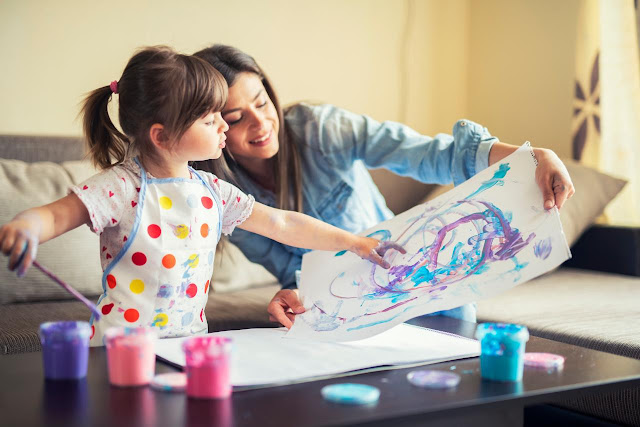The Benefits of Art in Child Development
Art is like magic for children. It's not just about creating pretty pictures; it's a gateway to a numerous developmental benefits. Imagine our children with apaintbrush in hand, dabbling in colors and shapes. With each stroke, they're not just making a mess; they're enhancing their cognitive abilities, honing their motor skills, and expressing their emotions.
TD
TDOne of the primary benefits of art in early childhood is its role in fostering creativity and imagination. When kids engage in art activities, they're encouraged to think outside the box, explore new ideas, and express themselves freely. This creativity becomes a foundation for problem-solving skills and innovative thinking later in life.
But wait,
there's more! Art isn't just about being creative; it's also a fantastic tool
for enhancing cognitive development. When children engage in art-making,
they're not just making random marks on paper; they're making connections in
their brains. From recognizing colors and shapes to understanding spatial relationships,
art provides a rich environment for cognitive growth.
What Skills Does Art Develop?
Now, let's
talk about the skills art nurtures in our little ones. It's not just about
producing masterpieces; it's about the journey of exploration and discovery. Through
art, children develop a range of skills that set the stage for success in
various aspects of their lives.
TD TD
First up,
fine motor skills. Have you ever watched a child carefully holding a crayon and
drawing intricate patterns? That seemingly simple act is actually helping them
refine their hand-eye coordination and dexterity. As they manipulate art
materials, their fingers and hands are getting a workout, laying the foundation
for activities like writing and tying shoelaces.
Art also
plays a significant role in emotional development. When children engage in art
activities, they have the opportunity to express their feelings and experiencesin a safe and non-verbal way. Whether they're painting a happy sun or
scribbling with frustration, art allows them to process and communicate their
emotions, fostering emotional intelligence and resilience.
Stages of Art Development in Early Childhood
Artisticdevelopment in early childhood unfolds like a beautiful story, with each stage
building upon the last. It all begins with simple scribbles and marks, as
toddlers delight in the newfound ability to leave their mark on the world. From
there, they progress to basic shapes and forms, experimenting with lines,
circles, and triangles.
As children
grow and develop, so does their artistic prowess. The next stage sees them
refining their skills, experimenting with different techniques and materials,
and gaining confidence in their abilities. By the time they reach preschool
age, many children are producing recognizable drawings and paintings, bursting
with creativity and imagination.
But artistic
development doesn't stop there. As children continue to explore and learn,
their artwork becomes more sophisticated, reflecting their evolving
understanding of the world around them. From realistic representations toabstract creations, each piece tells a unique story of growth and discovery.
Importance of Drawing and Painting in Child
Drawing and
painting are like the bread and butter of childhood art experiences. From the
moment they can grasp a crayon, children are drawn to these timeless activities
like bees to honey. And for good reason! Drawing and painting offer a host of
benefits that extend far beyond the canvas.
First and foremost, drawing and painting are powerful tools for self-expression. Whether it's a vibrant masterpiece or a simple doodle, each mark on the page is a reflection of the child's thoughts, feelings, and experiences. Through drawing and painting, children learn to communicate visually, expressing themselves in a language that transcends words.
TD TD
But drawing and painting aren't just about self-expression; they're also valuable tools for learning and exploration. As children create art, they're not just making pretty pictures; they're actively engaging with the world around them, making observations, asking questions, and seeking answers. Whether they're painting a still life or drawing a story, art provides a rich context for learning across a range of subjects.
In
conclusion, the importance of art in childhood cannot be overstated. From
fostering creativity and imagination to enhancing cognitive and emotionaldevelopment, art plays a vital role in shaping our little ones' lives. So let's
encourage them to pick up that paintbrush, grab those crayons, and unleash
their inner creative genius.
And remember,
it's not just about the final product; it's about the journey of discovery and
self-expression. So let's celebrate every scribble, every stroke, and every
splash of color, knowing that each one is a step towards a brighter, more
creative future.
TD TD


Comments
Post a Comment